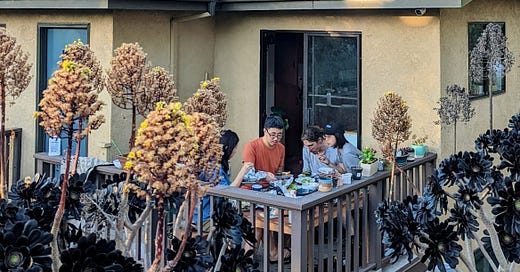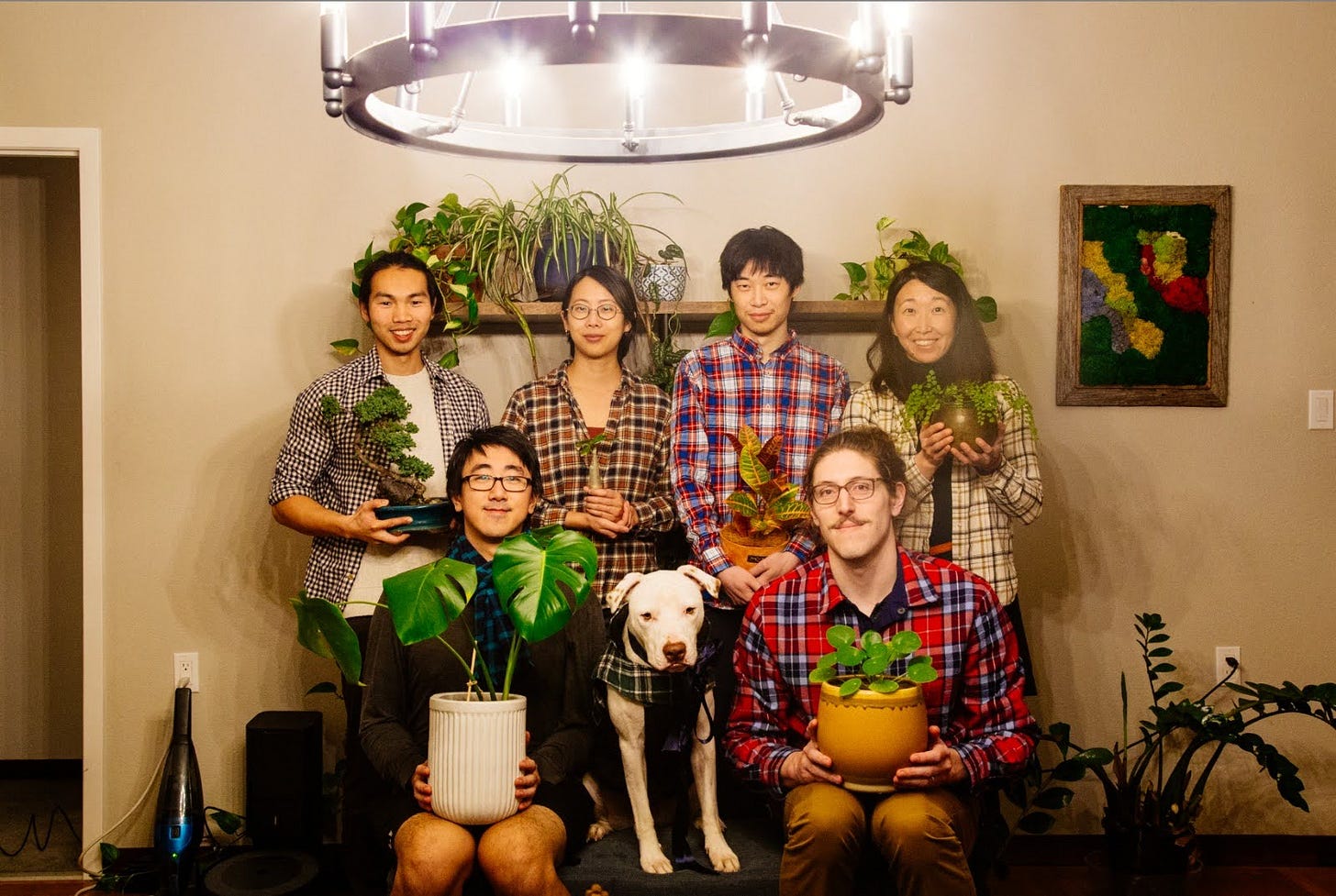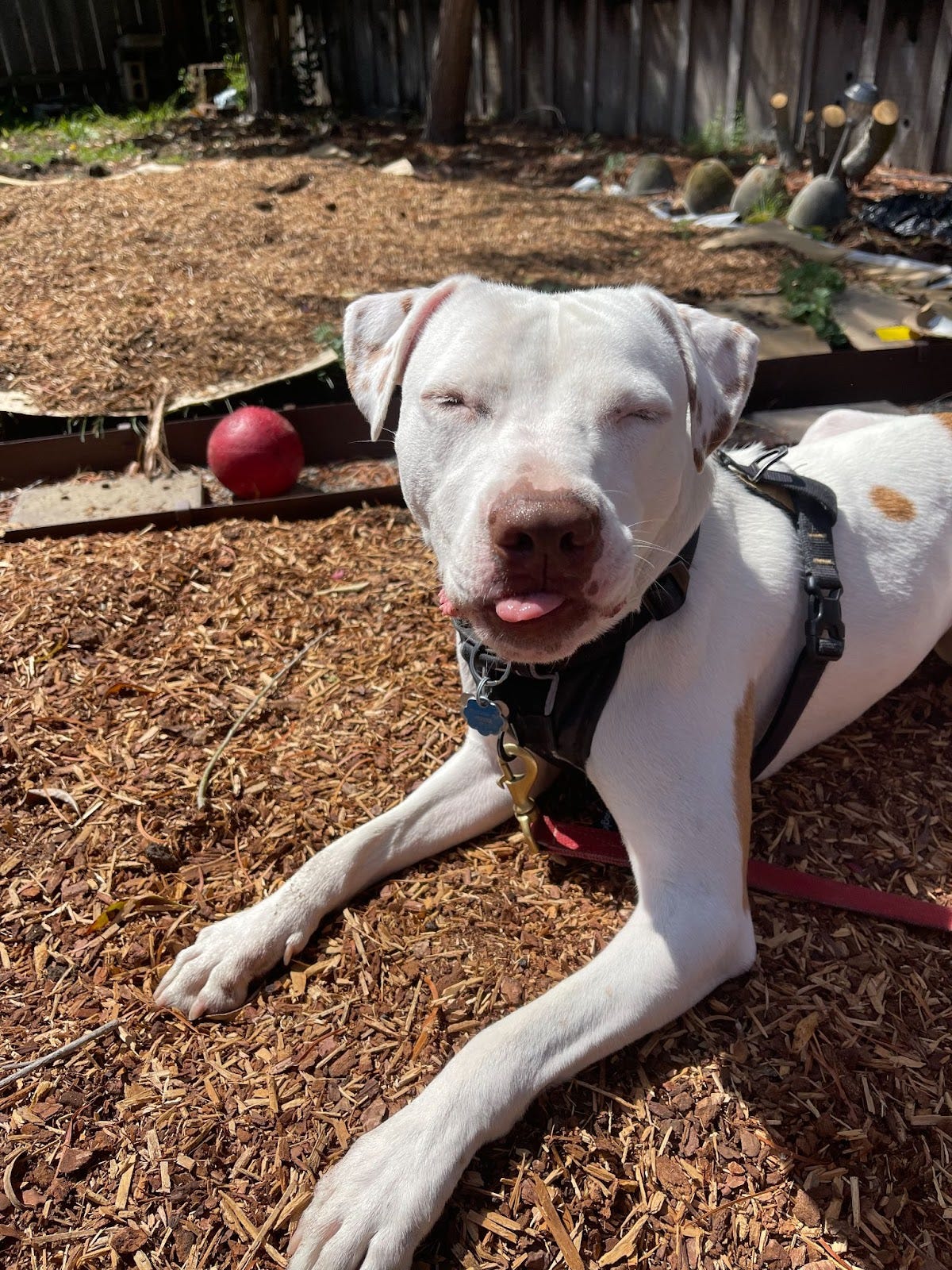Editor’s note: this case study was written by Nadia, one of the owner-residents of the house, and is not intended to reflect the opinions of everyone in the house. Nadia and her friends did what so many dreamed about during the pandemic: moved from a cramped apartment to buying a bigger house with their friends. Read on to find out how they are making it all work.
This is part of an ongoing series of deep dives on coliving spaces. To see others, visit the Supernuclear directory.
Name: The Palm on Deakin (we don’t really have an official name)
Date founded: Oct 2020
Location: Berkeley, CA
Rented or owned: Owned
Amount of space (number of beds/baths, any notable amenities):
5Br3Ba, ~3700 sqft. Two kitchens, which gave more flexibility and reduced congestion during mealtimes. Currently houses 5 adults, 1 dog, and 2 cats.Governance: a one-sentence description of how decisions get made
Small decisions are made casually & asynchronously through our Whatsapp chat (e.g., can I spend house funds to hire a plumber to fix the toilet?), while bigger decisions (e.g., long-term plans for the house) are discussed during ad-hoc house meetings.
Origins
June 2020. It was deep pandemic times, and 7 of us housemates were hunkered down in a house in SF, playing board games, cooking meals together, baking a lot of sourdough. What previously felt like a spacious home during normal times felt small, and, like many others, we started dreaming of a backyard, living closer to nature. Someone suggested “Hey, should we go check out some houses in the East Bay? Could be a fun weekend activity”, and before we knew it, we had a realtor, and were spending our weekends looking at homes.
Eventually, 4 of us (Nadia, Sherwin, Steph, Tim) decided to buy a house together in Berkeley. We had all lived together in SF, so we knew we’d be able to communicate openly and respectfully with one another, and to get along well. Our motives were multifold: we enjoyed communal living to varying degrees, and thought it’d be a good financial decision to pool our money together to purchase a house we wouldn’t otherwise have individually been able to afford.
The house has hosted different combinations of residents over the past years: when we first bought it, 3 of the owners + 3 of our close friends (we’ll call them housemates) moved in. Subsequently, we’ve had all 4 owners live in the house, and 3 owners + 1-4 housemates, at different points in time.
Inner Workings
The expectations and requirements are different for owners vs. housemates.
Housemates:
This doesn’t look too different from the inner workings of a home with multiple roommates, although I’d say we’re more informal than many households. We generally expect folks to clean up after themselves, pay rent on time, and the only assigned regular chore we had was taking out the trash. Our driveway fits a single car, so the housemates who own cars take turns using the driveway (e.g., I have driveway access in Jan, you have it in Feb, etc.). We have a shared Splitwise account for housemate expenses, e.g., shared groceries, internet bill.
Since our house has 2.5 storeys, with a kitchen on the main floor and one in the basement, this creates a natural division in the house - the folks whose rooms are in the basement tend to use the basement kitchen and downstairs space more; and vice versa for folks whose rooms are upstairs. The main communal space (living room) is located by the main entrance / exit of the house, which facilitates hanging out. Everyone has their own space, but it is a shared house with low barriers to spending time together.

Owners:
Governance - before we bought the house, we had a discussion around expectations (what happens if someone wants to move out? Wants to sell their share?) and codified them in a document. This document forms the baseline for long-term decision-making for the house. Beyond that, we have a number of more tactical / specific documents for different topics, e.g., how much rent will be for each room. All our documents are stored in a shared Asana project for future reference.
Finances - we set up a joint bank account when we took out our mortgage, and use this account for house-related financial transactions (e.g., paying our monthly mortgage). We also have monthly “HOA dues” so we have a pool of funds available for ad-hoc repairs or planned improvements.
For tracking of finances, we set up a shared Google Sheet to document and track all expenses (e.g., homeowner’s insurance) and revenue (primarily rent inflows). We don’t have a single bookkeeper, so everyone takes responsibility to ensure the Google Sheet is up to date and reflects the transactions in our joining bank account. It’s worth noting that not all the owners own an equal share of the house, so this sheet is important to accurately prorate the revenue and expenses associated with the house.
Lessons learned
Having a flexible house configuration can make a big difference in long-term sustainability.
Not long after we moved in, two of us (a couple) decided to adopt a dog, who turned out to be stranger-reactive (fearful of, and in turn aggressive towards, new people). This was fine during the early pandemic days, but proved to be challenging once things opened up and we started wanting to have friends over. Our dog was fine with our housemates, but whenever we wanted to have a new guest over, we’d need to have an extensive introduction process, and heavily monitor the dog-guest interaction.
We’ve been lucky that our housemates have been gracious and understanding about accommodating our dog’s needs, but the added friction to our ability to host does wear on everyone. If we had opted to purchase a house with more separation between living quarters, e.g., separate units with a shared communal space, we could more easily have created a separation between dog and guests. Likewise, as we transition through life stages, e.g., adding partners, starting families, our needs change, and the limitations of our home’s configurability can be a barrier to individuals’ decisions to stay on long-term.
Where there’s pre-existing trust, less process is needed.
We chose to open up our home only to friends or folks within our existing networks, rather than take in open applications. While there are obvious trade-offs with this decision (e.g., it might take longer to fill an empty room if someone moves out), ultimately it ensured that there was a high degree of trust within the group from the beginning. For example, the 4 owners co-manage our finances using a Google spreadsheet - and to be honest, if someone really wanted to, it wouldn’t be hard to fudge the numbers on that sheet. But we all trust one another to be honest, competent individuals with good intentions; and as a result, we didn’t feel like we needed to create too much process to maintain financial guardrails.
Legal and financial structures decisions have downstream impact - do your research and talk to people first!
When we decided to co-buy our home together, we had barely any experience with house-buying (1 of us had purchased a condo before, none of us had purchased a home with friends, or knew anyone who had). We didn’t know about Supernuclear, or of any other co-living resources. Overall, we did a pretty good job with decision-making given our lack of prior experience, but we wouldn’t have had to reinvent the wheel if we had had access to Supernuclear resources such as this and this.
For example, we went down the “everyone gets on the loan” (described in the 5 ways to get a loan article linked above) path for our mortgage. We knew this meant that each of us would be liable for the full amount of the loan payment if anyone decides to renege (we weren’t worried about this), but we didn’t realize it would also impact our Debt-to-Income (DTI) ratio, i.e., our individual ability to take out future loans. Had we known better, we might have decided to go down the LLC path instead.
In conclusion
Overall, we’ve felt privileged to be able to live with intentionality and in community with friends over the past few years. It’s taught us how to communicate better, resolve conflicts better, and to experience a version of living that’s different from Western societal conventions. We don’t know where our co-living journeys will take us in the future (or if co-living is even in the books for all of us longer term), but we’re thankful for the good memories and friendships we’ve created to date.
Suggested further reading:
If you found this helpful, know someone else who might? You know what to do!










Loving these case studies! Thank you!
I love reading these! I really want to create a co-living situation but haven’t seen any opportunities where I live in Orlando, FL. Still, reading all of these for the day I meet the right people and wanna make it happen!